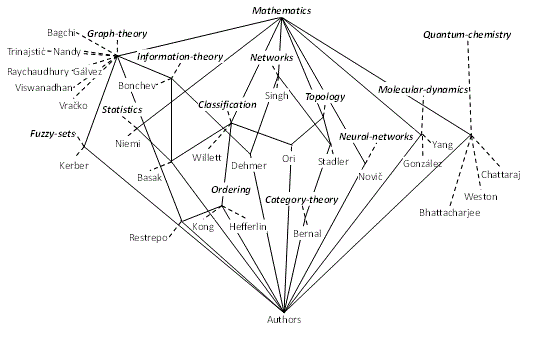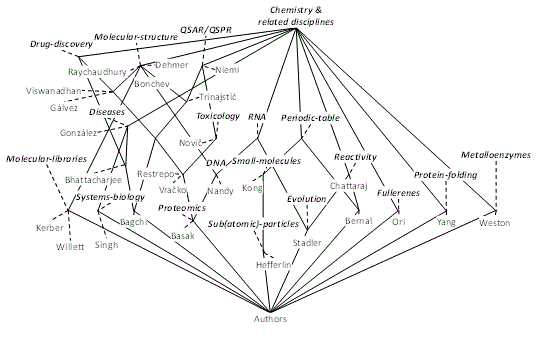The Universe is a grand book which cannot be read until one first learns to comprehend the language and become familiar with the characters in which it is composed. It is written in the language of mathematics.
Galileo Galilei
I dive down into the depth of the ocean of forms, hoping to gain the perfect pearl of the formless.
Rabindranath Tagore
The perfection of chemistry might be secured and hastened by the training of the minds of chemists in the mathematical spirit [...]. Besides that mathematical study is the necessary foundation of all positive science, it has a special use in chemistry in disciplining the mind to a wise severity in the conduct of analysis: and daily observation shows the evil effects of its absence.
Auguste Comte
In this eBook we introduce our readers to one of the most comprehensive and thematically diverse
treatise on the emerging discipline of mathematical chemistry, or, more accurately, discrete
mathematical chemistry. Although mathematical representation and characterization of chemical objects
were known for a long time, the incursion of discrete mathematics into chemistry had a tremendous
growth spurt in the second half of the twentieth century and the trend is continuing even today in an
unabated manner. We think such a growth has been fueled and sustained primarily by two factors: i)
Novel applications of discrete mathematics to chemical and biological systems, and ii) Availability of
high speed computers and associated software whereby hypothesis driven as well as discovery oriented
research can be carried out within a reasonable time frame. This trend of research has led not only to the
development of many novel concepts, but also to numerous useful applications to scientifically, socially
and economically important areas such as drug discovery, protection of human as well as ecological
health, chemoinformatics, bioinformatics, toxicoinformatics, and computational biology, to name just a
few. This book is a clear depiction of those concepts and applications.
Another perspective of Mathematical Chemistry is the very mathematics-chemistry relationship,
which also shows its growing community. If we look at journals devoted exclusively to the link
between mathematics and particular natural sciences, then the Journal of Mathematical Physics
has to be mentioned first, for it appeared for the first time in 1960; at that time, both chemistry and
biology lagged behind physics. Fourteen years later, the Journal of Mathematical Biology was
launched and one year later the first journal for mathematical chemistry showed up: MATCH
Communications in Mathematical and in Computer Chemistry. Later, in 1987, the Journal of
Mathematical Chemistry was initiated and just recently (2010) the Iranian Journal of
Mathematical Chemistry published its first issue. The reasons for such a delay, in contrast with
physics, have recently been a matter of discussion among philosophers of science, particularly of
chemistry, where HYLE - International Journal for Philosophy of Chemistry has played a central
role. The fact of being the last of the three sciences in launching a scientific journal devoted to its
relationship with mathematics contrasts with the three journals specifically devoted to such a link.
This suggests the growth of the community, where a single journal is not able to cope with the
amount of novel results in the area of mathematical chemistry.
A seminal piece of research in modern mathematical chemistry was the path breaking work of
Harry Wiener (1947), which stimulated a wealth of investigations on applications of discrete
mathematics in chemistry, e.g., graph theory, matrix theory, and information theory. In the early
1980s, Professors R. Bruce King and Dennis H. Rouvray accelerated this process by the initiation
of the International Conference on Mathematical Chemistry series at the University of Georgia at
Athens, Georgia, USA. The conferences under the leadership of King and Rouvray were organized
in North America and Europe during 1983-2005 and the conference proceedings attest to the high
scientific standard of discourse in those events, where not only the mathematical theories
aforementioned found a fertile land but also topology and group theory, to name but a few more.
These conferences led to numerous discussions on the organization of the community of people
delving into the wonders of the chemomathematical relationship. Hence, the International Society
of Mathematical Chemistry (ISMC) was founded in 1987 with Professor Milan Randić being its
President till 2003; thereafter Subhash C. Basak took over the presidency of ISMC from Professor
Randić. An important meeting point of members of the community is the MATH/CHEM/COMP
symposium, traditionally organized in Dubrovnik (Croatia) for more than 25 years. This yearly
series seeks to foster the exchange of ideas among chemists, mathematicians, and computer
scientists; there is no doubt of the importance this meeting has for the mathematical chemistry
community, which owes much to Professor Ante Graovac, who recently passed away (2012), and
who was always behind the organization of the MATH/CHEM/COMP meetings. As part of the
growing process, mathematical chemists looked for another type of organization, this time an
academy, namely the International Academy of Mathematical Chemistry1 (IAMC), founded in
2005, which also organizes a yearly symposium. The organizational seed of the Balkans soon
crossed the oceans and went to India and USA. In the 1990s, Subhash C. Basak and Dilip K. Sinha
initiated the Indo-US Workshop on Mathematical Chemistry series2, whose aim was to bring both
senior scientists and young scholars to a single and homely forum to discuss the advancing
frontiers of mathematical chemistry and allied sciences. In 2007, with the objective of bringing the
young scholars in close contact with the internationally renowned experts for exclusive mentorship
and training, the Indo-US Lecture Series on Discrete Mathematical Chemistry3 was established.
More recently, this enthusiasm for mathematical chemistry infected South America and led to the
creation of the Mathematical Chemistry Workshop of the Americas,4 involving countries of North
and South Americas.
At such an astonishing historical moment of a scientific community that has been able to organize,
create, and use the needed intellectual fermentation and communication channels to keep growing,
this book comes into play. The 27 chapters of the current book are derived from multiple sources:
i) Papers presented at the Second Mathematical Chemistry Workshop of the Americas in Bogota,
Colombia, in 2011; ii) Papers presented at the First Indo-US Lecture Series on Discrete
Mathematical Chemistry in Bangalore, India (2007), and iii) Invited chapters from distinguished
researchers in Mathematical Chemistry and related areas. These chapters deal both with the
development and history of the basic concepts as well as their applications. They also show the
fruitful relationship between different branches of mathematics and chemistry and related
disciplines. The branches of mathematics considered are graph, information and category theories,
as well as statistics, fuzzy sets, network analysis, classification techniques, ordering, topology,
neural networks and mathematical aspects of molecular dynamics and quantum chemistry. Due to
the large number and scientific diversity of the chapters in the current book, an attempt to
summarize the aforementioned branches of mathematics interacting with chemistry goes beyond
our capabilities in the limited space of this preface. What we have done, instead, is to use
mathematics to guide the reader through the multiple paths this book offers, which in the end
constitutes a book of several (finite) sub-books. In this sense, this book, besides containing the
current status of Mathematical Chemistry, is also a Rayuela4, a combinatorial book like the one by
the famous writer Julio Cortazar. We show in the following figure a map, based on order theory, to
explore the book depending on the particular interests of our readers. Each node in the graph
contains two kinds of information: a set of mathematical branches (italics) and a set of authors; for
the sake of simplicity we have labeled each chapter by the surname of its corresponding author.
Once a node is selected, all those nodes found in a downward path give information about the node
selected, e.g. if we are interested in “Information theory”, then the respective node shows that
Bonchev’s chapter as well as Basak(1)’s, and Dehmer’s chapters are related to that mathematical
branch. Likewise, if we are interested in “Topology”, then the authors to read are Ori, Stadler, and
Bernal; the latter two being also related to “Category theory”.

As the book also shows the result of the incursion of the above mentioned branches of
mathematics with chemistry and other disciplines, then we drew another diagram depicting how
authors’ chapters are related to several areas of knowledge. For example, we see that the chapters
relating mathematics with RNA are those by Nandy, Basak(1), and Stadler. The areas chemical
and related disciplines considered by the authors are: Drug discovery processes, molecular
structure characterizations, QSAR/QSPR models related studies to tackle several diseases, models
for toxicology, RNA studies, periodic tables, algorithms for exploring molecular libraries, systems
biology, proteomics, DNA characterizations, studies of small molecules, biological evolution,
chemical reactivity, protein folding studies, fullerenes’ and metalloenzymes characterizations.
Both diagrams can also be read in the upward direction, where the information extracted is on the
topics tackled by the authors. Hence, if we take, e.g. Viswanadhan, we see that his chapter is on
Drug discovery and Molecular structure, combined with Graph theory.

Which kinds of readers do we expect for our book? The book is useful to the uninitiated with some
grounding in chemistry, mathematics and biology, e.g., senior undergraduate students; graduate students
/ postdocs as well as senior researchers who wish to get started as new investigators in the field.
To conclude, we would like to take the opportunity of thanking all those who have assisted in any
way with the realization of this project. Certainly included here are all the authors who have
contributed with their important chapters; Professors Balaban and Kier, leading Mathematical
Chemistry figures of our time, who kindly wrote their inspiring forewords for our book; Professor
Esperanza Paredes, Dean of the Universidad de Pamplona (Colombia) and Professors René Meziat
and Wolfram Baumann, heads of the Departments of Mathematics and Chemistry, respectively, of
the Universidad de los Andes (Colombia), who gave us the financial support to have the Second
Mathematical Chemistry Workshop of the Americas organized in Colombia, and Wilmer Leal, who
formatted the chapters according to Bentham Science Publishers guidelines.
Subhash C. Basak, being already involved in the organization of a total thirteen events in the three
mathematical chemistry workshop series mentioned above, has been immensely helped by
numerous colleagues, friends, and collaborators (called members of his virtual team) the long list
of whom cannot be mentioned here for brevity. Help extended to Basak by Dilip K. Sinha (former
Vice-Chancellor of Visva Bharati University, Santiniketan, India), Michael J. Lalich (Former
director, University of Minnesota Duluth- Natural Resources Research Institute, UMD-NRRI,
USA), Ashok Kolaskar (former Vice Chancellor, University of Pune, India); Brian Gute, Denise
Mills, Gerald Niemi, Donald Harriss, Vincent Magnuson, Gregory Grunwald from UMD/ NRRI;
Kanika Basak, Sarat Basak, Moumita Basak, Nabamita Basak; Indira Ghosh, Uma Vuruputuri,
Manish Bagchi, Ramanathan Natarajan, R. Balakrishnan, S. Parthasarathy, Subhendu Gupta,
Ashesh Nandy, Vellarkad Viswanadhan, Chandan Raychaudhury, Marimuthu Ramalingam, P.
Venuvanalingam, Tarun Jha, Mohanraj Subramanian, M. Srinivasan, from India; Gilman Veith,
Milan Randić, Krishnan Balasubramanian, Moiz Mumtaz, Apurba Bhattacharjee, Kevin Geiss,
Frank Witzmann, Chandrika Moudgal, George Vacek, from USA; Kannan Krishnan, Shahul Nilar
(Canada); Marjan Vračko, Marjana Novič from Slovenia; Vladimir Palyulin, Nikolay Zefirov from
Russia; Rainer Brüggemann (Germany) and Haruo Hosoya (Japan), are gratefully acknowledged.
We are thankful to the staff of Bentham Science Publishers, Ms. Asma Ahmed in particular, for
the untiring efforts in all aspects of the publication of this book.
We sincerely hope that the two volumes of the eBook Advances in Mathematical Chemistry will
not only apprise its readers of the advancing frontiers of mathematical chemistry along with its
wide variety of applications, but also will stimulate further research in the field both by young
scholars and senior researchers.
Subhash C. Basak
International Society of Mathematical Chemistry
University of Minnesota
USA
Guillermo Restrepo
Universidad de Pamplona
Colombia
&
José L. Villaveces
Universidad de los Andes
Colombia



